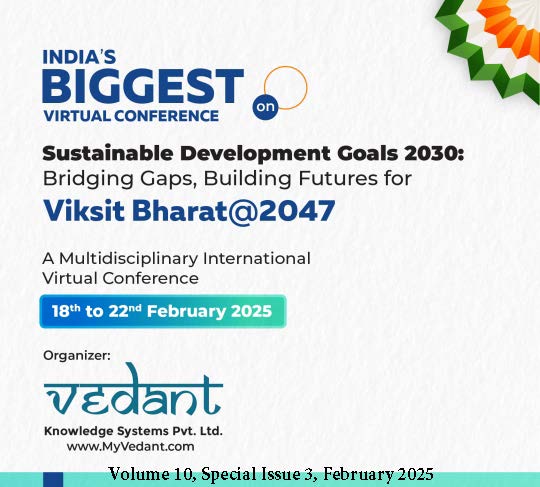SDG 2030: VIKSIT BHARAT 2047-ROLE OF INDIAN URBAN HOUSEWIVES
DOI:
https://doi.org/10.58213/vidhyayana.v10isi3.2236Keywords:
SDG 2030, Viksit Bharat 2047, Urban Housewives, GYAN-Nari-The Female, Sustainable GoalsAbstract
SDG 2030 has 17 goals and 169 targets driven by the principle of “Leaving No One Behind” (LOBO). “SDG framework is a unique articulation of public interest on a global scale”. Viksit Bharat 2047 refers to India’s vision of becoming self-reliant, fully developed, and globally influential by 2047.
2047 is the year when our freedom will complete 100 years. Viksit Bharat 2047 aligns with SDG 2030. It is based on “GYAN”, which represents four pillars: Garib (The Poor), Yuva (The Youth), Anndata (The Farmer), and Nari (The Female).
Globally, females have a tremendous role to play in achieving SDG 2030. In 2011 181,616,925.000 females were Urban females, according to consensus. The female population percentage of India's total population was 48.42% in 2023. According to the World Bank collection of development indicators, the female (% of total population) in India was reported at 48.42 % in 2023.
India’s total urban population has increased significantly. It is estimated to be around 35-40 % of total population. However, the urban female population is still hovering around 48%. Estimated Urban Housewives Population: Urban women constitute approximately 35-40% of India’s total urban population (as of 2023 estimates). Assuming urban women number around 200-220 million in 2023 and considering that 80% or more are housewives, the urban housewife population is likely around 160-180 million.
The contribution of Urban housewives is often overlooked, when their role spans multiple dimensions, including environmental sustainability, education, economic participation, and community building. Their number is huge; consequently, a wider role can be expected in achieving Sustainable Development Goals (SDG 2030) and achieving the vision of Viksit Bharat 2047. Also, females are one of the four pillars of the vision of Viksit Bharat 2047, “GYAN”-Nari-The Female
This paper deals with urban housewives' inclusivity and explores how they can actively advance sustainable development, foster inclusivity, and contribute to India’s socio-economic growth.
Downloads
References
https://pib.gov.in/PressReleasePage.aspx?PRID=2088390
https://en.wikipedia.org/wiki/Efficient_energy_use
https://sdgs.un.org/goals/goal4
https://www.unep.org/explore-topics/resource-efficiency/what-we-do/sustainable-lifestyles
https://cleartax.in/s/viksit-bharat-2047
https://kuey.net/index.php/kuey/article/download/4521/3036/9924
https://business.yougov.com/content/28284-three-ten-urban-indian-women-claim-they-cannot-do-
https://www.niti.gov.in/sites/default/files/2024-07/SDA_INDIA_Publication.pdf
https://www.niti.gov.in/sites/default/files/2024-07/SDA_INDIA_Publication.pdf
